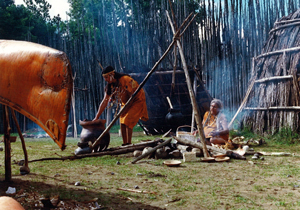
The Late Woodland period of 800 A.D. to 1650 A.D. spans the origins of various Iroquoian speaking tribal confederacies in southern Ontario, including the Huron, Petun, and Neutral.
Stone projectile points and tools, pottery fragments, and other artifacts have been found scattered across farmlands in the Rouge River floodplain over the past several decades. These artifacts date back to the Late Woodland Period. Concentrations of these artifacts and the discovery of ossuaries, or burial pits, point to the existence of semi-permanent aboriginal villages throughout what is now the City of Markham.
One of the more significant discoveries was made in the 1870s by Thomas A. Milne, a local mill owner, who collected artifacts found on his farm. The mainly “flint arrowheads, tomahawks, pipes, etc.” were put on display in the office of the Markham Economist newspaper. The Milne family were still collecting artifacts from their property as late as 1921. Archaeologists believe they were from a village that once stood within what is today the Milne Conservation Area.
Another of the early archaeological discoveries was a large ossuary that was found in the 1950s on the west bank of the Rouge River, south of Highway 7. The many artifacts found prove that there was a year-round Aboriginal community in Markham long before the arrival of European settlers in the 1700s.
